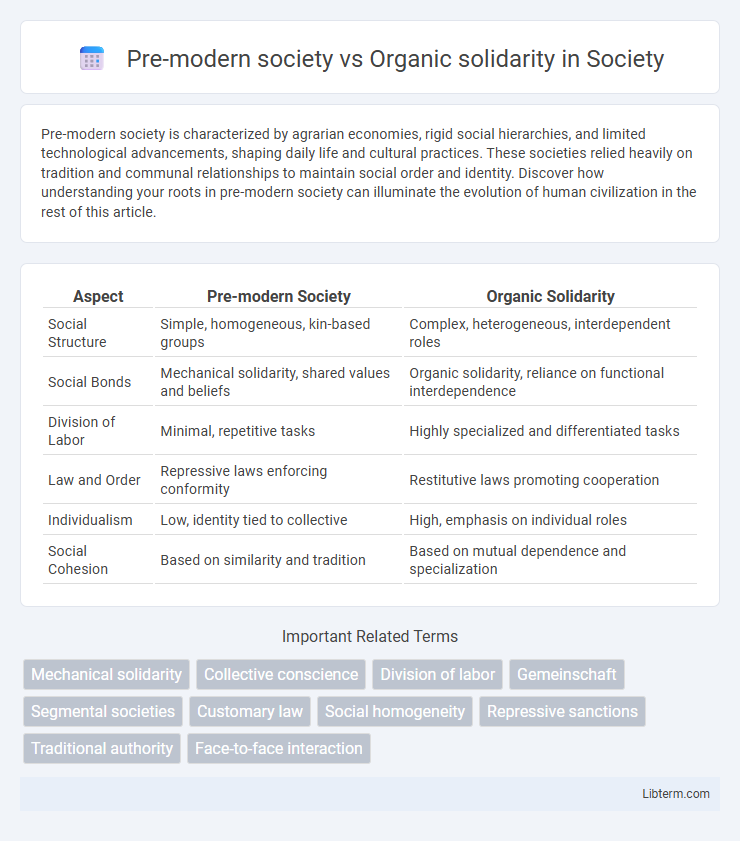Pre-modern society is characterized by agrarian economies, rigid social hierarchies, and limited technological advancements, shaping daily life and cultural practices. These societies relied heavily on tradition and communal relationships to maintain social order and identity. Discover how understanding your roots in pre-modern society can illuminate the evolution of human civilization in the rest of this article.
Table of Comparison
| Aspect | Pre-modern Society | Organic Solidarity |
|---|---|---|
| Social Structure | Simple, homogeneous, kin-based groups | Complex, heterogeneous, interdependent roles |
| Social Bonds | Mechanical solidarity, shared values and beliefs | Organic solidarity, reliance on functional interdependence |
| Division of Labor | Minimal, repetitive tasks | Highly specialized and differentiated tasks |
| Law and Order | Repressive laws enforcing conformity | Restitutive laws promoting cooperation |
| Individualism | Low, identity tied to collective | High, emphasis on individual roles |
| Social Cohesion | Based on similarity and tradition | Based on mutual dependence and specialization |
Defining Pre-Modern Society
Pre-modern society is characterized by small, agrarian communities with limited social differentiation and a reliance on traditional customs and familial ties for social cohesion. Organic solidarity emerges in more advanced, industrial societies where social cohesion is based on the interdependence of specialized individuals and institutions. Unlike pre-modern societies, organic solidarity reflects increased complexity and division of labor, fostering social integration through functional interrelation.
Understanding Organic Solidarity
Organic solidarity emerges in complex, industrial societies where social cohesion is maintained through the interdependence of individuals performing specialized roles. This form of solidarity contrasts with pre-modern societies, which rely on mechanical solidarity characterized by homogeneity and shared beliefs. Understanding organic solidarity requires recognizing how modern social structures depend on cooperation and differentiation to sustain social order.
Historical Context: From Tradition to Modernity
Pre-modern society, characterized by mechanical solidarity, relied on shared traditions, homogenous beliefs, and collective conscience to maintain social cohesion. Organic solidarity, emerging in modern societies, is based on specialized roles, interdependence, and complex division of labor reflecting industrialization and urbanization from the 18th century onward. This transition marks a shift from agrarian, tightly-knit communities to heterogeneous, dynamic social structures driven by economic and technological advancements.
Key Features of Pre-Modern Societies
Pre-modern societies are characterized by mechanical solidarity, where social cohesion arises from shared beliefs, values, and similar lifestyles. These societies typically have simple division of labor, strong collective conscience, and emphasize kinship and tradition. Organic solidarity, in contrast, emerges in modern societies with complex division of labor and interdependence among specialized individuals.
Characteristics of Societies with Organic Solidarity
Societies with organic solidarity exhibit complex division of labor where individuals perform specialized roles, creating interdependence essential for social cohesion. Unlike pre-modern societies characterized by mechanical solidarity with homogeneity and shared values, organic solidarity thrives on diversity and cooperation among different social functions. This form of solidarity fosters legal systems based on restitutive law, emphasizing the restoration of social equilibrium rather than punishment.
Social Structure: Hierarchy vs Interdependence
Pre-modern society features a rigid social hierarchy characterized by fixed roles and clear authority lines, where individual identity is tied to one's position within a stratified system. Organic solidarity emerges in complex societies based on interdependence, where social cohesion relies on the specialization of functions and mutual reliance among diverse individuals and groups. This shift transforms social structure from hierarchical dominance to collaborative networks, emphasizing cooperation over traditional authority.
Role of Division of Labor
Pre-modern society relied on mechanical solidarity, where individuals performed similar tasks and shared common beliefs, resulting in minimal division of labor. In contrast, organic solidarity in modern societies is characterized by a complex division of labor, with specialized roles fostering interdependence among individuals. This specialization enhances social cohesion by creating a network of mutual reliance based on diverse functions and expertise.
Collective Conscience: Traditional vs Modern
Pre-modern societies exhibit a strong collective conscience characterized by homogeneity, shared beliefs, and rigid social norms that enforce conformity and social cohesion. In contrast, organic solidarity in modern societies arises from the differentiation and interdependence of specialized roles, where collective conscience becomes more diffuse, allowing individual autonomy and diversity of values. Durkheim emphasized that while pre-modern collective conscience binds through similarity, modern solidarity relies on complementary differences fostering social integration.
Social Integration and Cohesion
Pre-modern societies are characterized by mechanical solidarity where social integration is based on similarities, shared values, and collective consciousness, fostering cohesion through homogeneity. Organic solidarity emerges in complex, industrial societies with diverse, interdependent roles that promote social integration through specialization and cooperation. Cohesion in organic solidarity relies on the mutual dependence of differentiated individuals and institutions, contrasting with the uniformity-driven integration of pre-modern forms.
Transformations and Impacts of Societal Change
Pre-modern societies are characterized by mechanical solidarity, where social cohesion arises from shared beliefs and similarities among individuals, resulting in simple, homogenous communities. The shift to organic solidarity marks a transformation toward complex, interdependent social structures driven by economic specialization and individual differences, fostering dynamic social relationships and increased social integration. This evolution impacts societal functions by promoting diversity, innovation, and adaptability while challenging traditional norms and collective identities.
Pre-modern society Infographic

 libterm.com
libterm.com